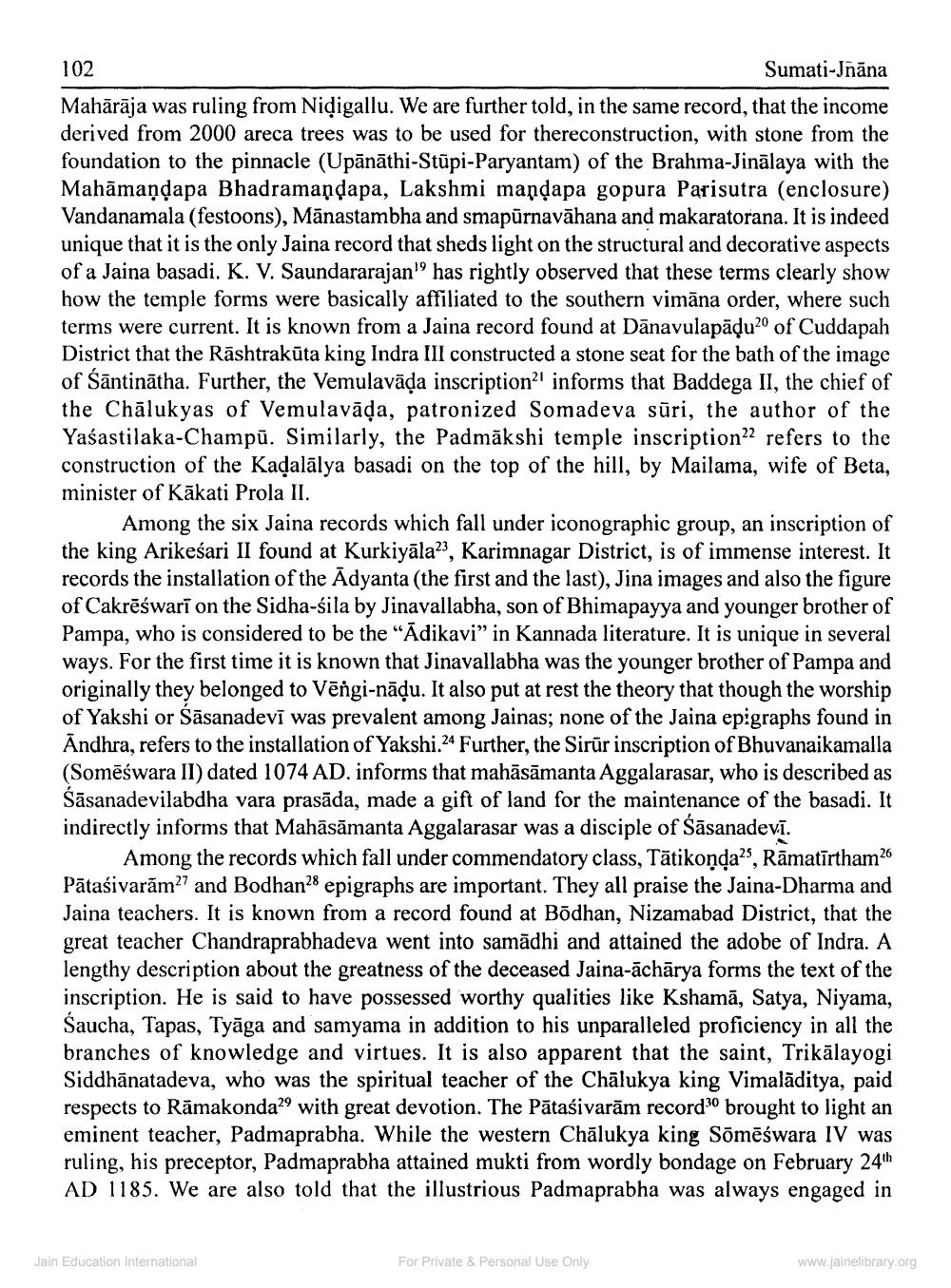________________
102
Sumati-Jnāna Mahārāja was ruling from Nidigallu. We are further told, in the same record, that the income derived from 2000 areca trees was to be used for thereconstruction, with stone from the foundation to the pinnacle (Upānāthi-Stūpi-Paryantam) of the Brahma-Jinālaya with the Mahāmaņdapa Bhadramandapa, Lakshmi mandapa gopura Parisutra (enclosure) Vandanamala (festoons), Mānastambha and smapūrnavāhana and makaratorana. It is indeed unique that it is the only Jaina record that sheds light on the structural and decorative aspects of a Jaina basadi. K. V. Saundararajan'' has rightly observed that these terms clearly show how the temple forms were basically affiliated to the southern vimāna order, where such terms were current. It is known from a Jaina record found at Dānavulapādużo of Cuddapah District that the Rāshtrakūta king Indra III constructed a stone seat for the bath of the image of Sāntinātha. Further, the Vemulavāda inscriptional informs that Baddega II, the chief of the Chālukyas of Vemulavāda, patronized Somadeva sūri, the author of the Yaśastilaka-Champū. Similarly, the Padmākshi temple inscription22 refers to the construction of the Kadalālya basadi on the top of the hill, by Mailama, wife of Beta, minister of Kākati Prola II.
Among the six Jaina records which fall under iconographic group, an inscription of the king Arikeśari II found at Kurkiyāla 3, Karimnagar District, is of immense interest. It records the installation of the Ādyanta (the first and the last), Jina images and also the figure of Cakrēśwarī on the Sidha-sila by Jinavallabha, son of Bhimapayya and younger brother of Pampa, who is considered to be the "Ādikavi” in Kannada literature. It is unique in several ways. For the first time it is known that Jinavallabha was the younger brother of Pampa and originally they belonged to Vēngi-nāļu. It also put at rest the theory that though the worship of Yakshi or Sāsanadevī was prevalent among Jainas; none of the Jaina epigraphs found in Andhra, refers to the installation of Yakshi.24 Further, the Sirūr inscription of Bhuvanaikamalla (Somēśwara II) dated 1074 AD. informs that mahāsāmanta Aggalarasar, who is described as Šāsanadevilabdha vara prasāda, made a gift of land for the maintenance of the basadi. It indirectly informs that Mahāsāmanta Aggalarasar was a disciple of Śāsanadevī.
Among the records which fall under commendatory class, Tātikonda25, Rāmatīrtham26 Pātaśivarām? and Bodhan28 epigraphs are important. They all praise the Jaina-Dharma and Jaina teachers. It is known from a record found at Bödhan, Nizamabad District, that the great teacher Chandraprabhadeva went into samādhi and attained the adobe of Indra. A lengthy description about the greatness of the deceased Jaina-āchārya forms the text of the inscription. He is said to have possessed worthy qualities like Kshamā, Satya, Niyama, Saucha, Tapas, Tyāga and samyama in addition to his unparalleled proficiency in all the branches of knowledge and virtues. It is also apparent that the saint, Trikālayogi Siddhānatadeva, who was the spiritual teacher of the Chālukya king Vimalāditya, paid respects to Rāmakonda2' with great devotion. The Pātaśivarām record brought to light an eminent teacher, Padmaprabha. While the western Chālukya king Sõmēswara IV was ruling, his preceptor, Padmaprabha attained mukti from wordly bondage on February 24th AD 1185. We are also told that the illustrious Padmaprabha was always engaged in
Jain Education International
For Private & Personal Use Only
www.jainelibrary.org




